- 注册
- 登录
- 小程序
- APP
- 档案号


德国gmp建筑设计有限公司 · 2024-03-07 15:10:30
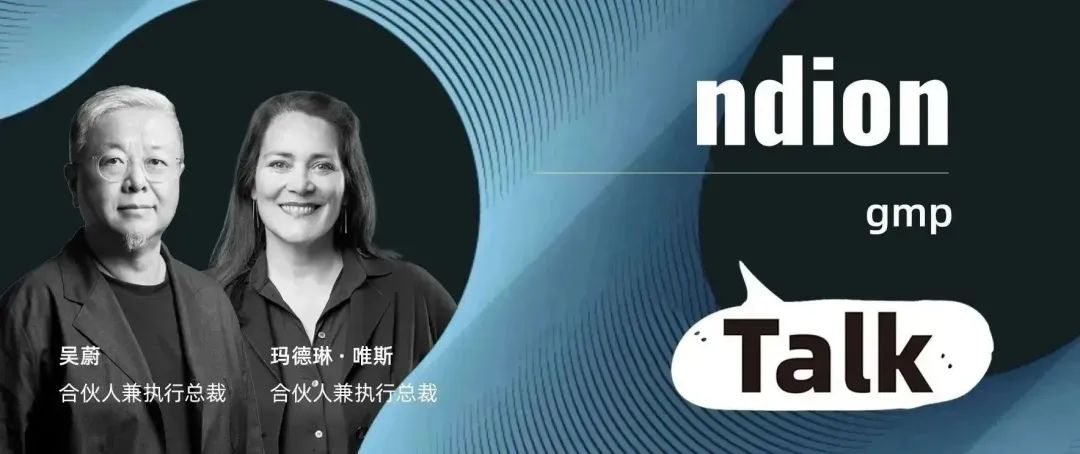
德国ndion独家专访
gmp·冯·格康,玛格及合伙人建筑师事务所合伙人兼执行总裁吴蔚、玛德琳·唯斯
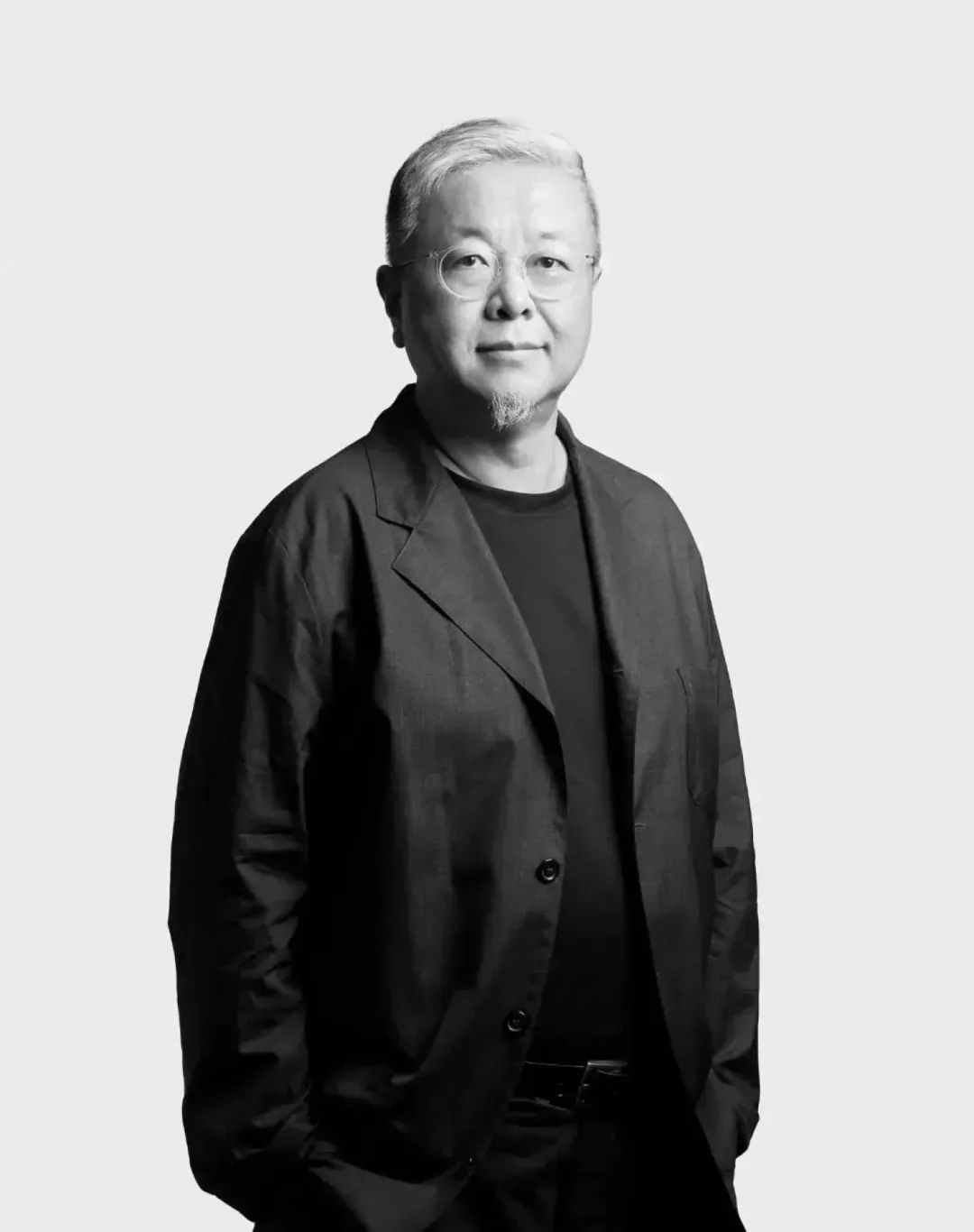
吴 蔚
Wei Wu
合伙人兼执行总裁
Executive Partner
吴蔚曾在重庆建筑工程学院学习建筑学,于 1992年至 1994年在兰州及上海从事建筑设计工作。1995年开始在瑞士苏黎世联邦理工大学 (ETH) 建筑系继续学习,并于 2000年在马里奥·坎培教授指导下完成毕业设计,获得建筑学硕士学位 (Diplom)。在瑞士苏黎世 Skyline Architecture 建筑师事务所工作后,吴蔚于 2001年起加入 gmp·冯·格康,玛格及合伙人建筑师事务所任北京及上海办公室的首席代表,2004年起任 gmp 项目合伙人,2009年成为中国区合伙人,2019年成为合伙人兼执行总裁。
After completing his studies in Chongqing, China, Wu Wei worked as an architect in Lanzhou and Shanghai from 1992 to 1994. In 1995 he started further architectural studies at ETH Zurich, where he studied under Prof. Mario Campi and finished with a Diplom-Ing. (master's degree) in 2000. After working for the Zurich practice Skyline Architecture, Wu joined gmp · Architects von Gerkan, Marg and Partners in 2001, where he initially started as Chief Representative of the offices in Beijing and Shanghai. In 2004 he became an Associate Partner, in 2009 Partner for China and then Executive Partner in 2019.
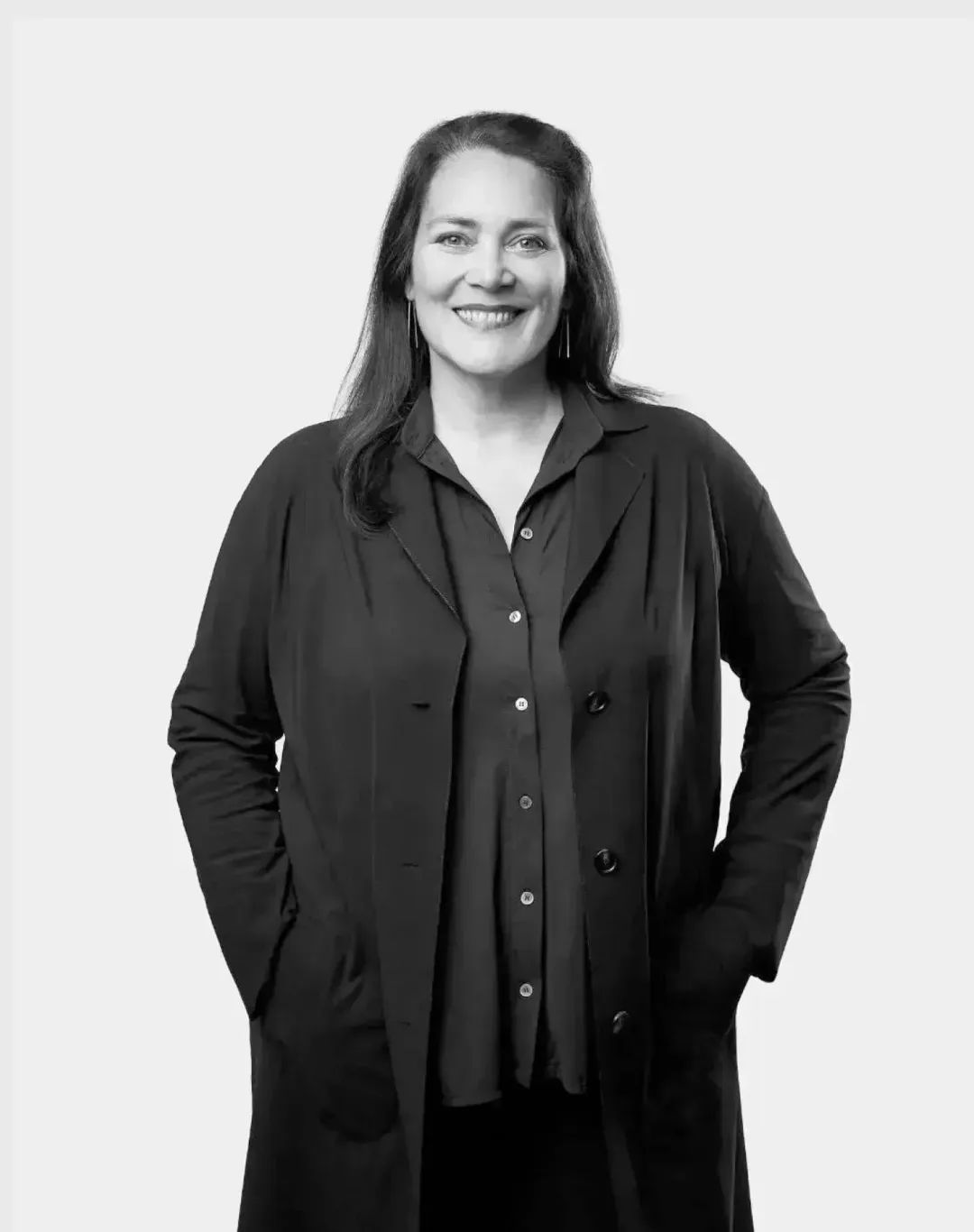
玛德琳·唯斯
Magdalene Weiss
合伙人兼执行总裁
Executive Partner
玛德琳·唯斯自2004年起负责上海分部的工作,并于2023年成为gmp·冯·格康,玛格及合伙人建筑师事务所的合伙人兼执行总裁。她曾在德国斯图加特和卡塞尔学习建筑,于1997年加入gmp。在德国范围内,她参与了柏林选帝候大街转角瑞士酒店项目。多年来她在中国担任了许多知名项目的负责人,其中包括上海东方体育中心、苏州奥林匹克体育中心、常州文化广场、漕河泾新洲大楼和上海保利绿地广场。
Magdalene Weiss became Executive Partner in 2023. She has been managing gmp’s branch in Shanghai since 2004. Weiss studied architecture in Stuttgart and Kassel and joined gmp in 1997. In Germany she was involved in the design of the Swissôtel Berlin project at Kurfürstendamm. Over the years she has managed a number of prestigious projects in China, including the Shanghai Oriental Sports Center, the Suzhou Sports Park, the Changzhou Cultural Center, the Caohejing Xinzhou Mansion and the Poly Greenland Plaza in Shanghai.
PUBLISHED ON 7. DECEMBER 2023
原文发表于2023年12月7日
Interview by Fabian Peters
德国《Baumeister》杂志主编法比安·彼得斯采访
Wei Wu (left) and Magdalene Weiss (right)
Photo: Lukas Schramm
吴蔚(左)和 玛德琳·唯斯(右)
摄影:Lukas Schramm
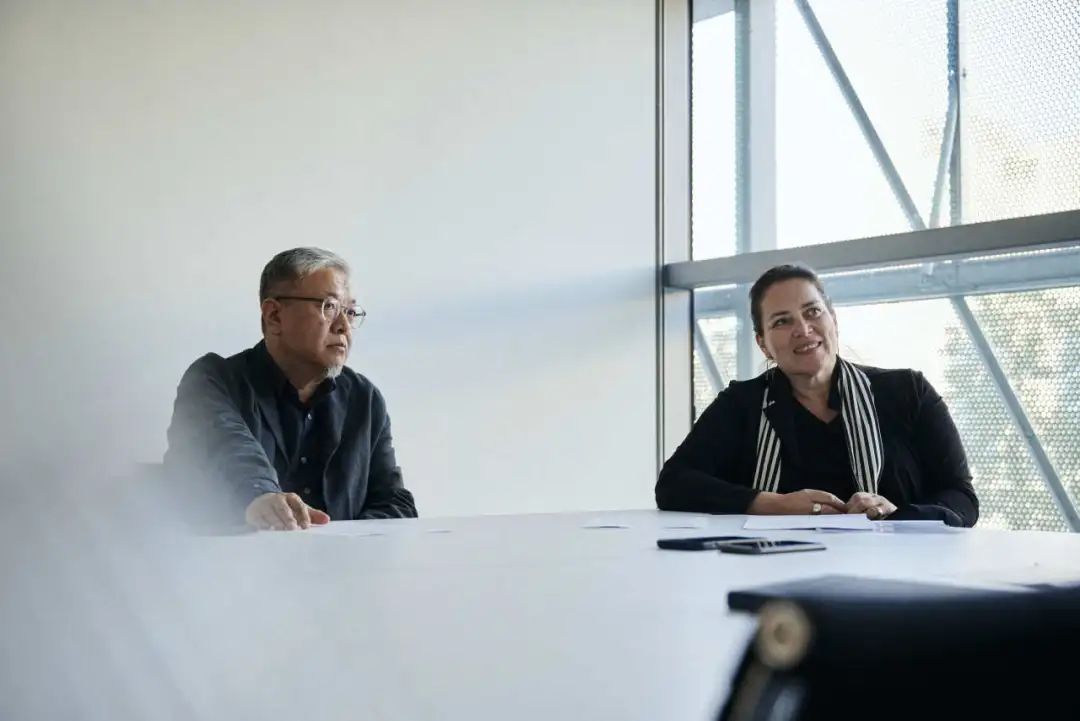
Grand gestures and meaningful places: If you want to successfully design large-scale projects in China, you have to adapt to different needs and circumstances than in Europe. Wei Wu and Magdalene Weiss, Executive Partners at architecture firm gmp ∙ von Gerkan, Marg and Partners, explain how gmp is helping to shape the Chinese architectural landscape and the challenges they face in the process.
中国是适合建设标志性项目的国度。但在中国设计和建造地标性项目,必须适应与欧洲完全不同的需求环境。gmp合伙人兼执行总裁吴蔚和玛德琳·唯斯娓娓道来,gmp在过去的二十五年时间里,如何克服面临的多重挑战,成功塑造诸多中国城市地标项目并脱颖而出的故事。
Q
Fabian Peters:
At the Iconic Awards 2023: Innovative Architecture, gmp received several awards for major projects in China, including for the “Silk Road International Conference Centre” in Xi’an and for the “Changzhou Culture Plaza”. Is there a particular quality that links the two buildings?
法比安:
2023年标志性建筑设计奖,gmp多个项目获奖。请问西安丝路国际会议中心和常州文化广场这两座建筑之间有什么特别共通的品质?
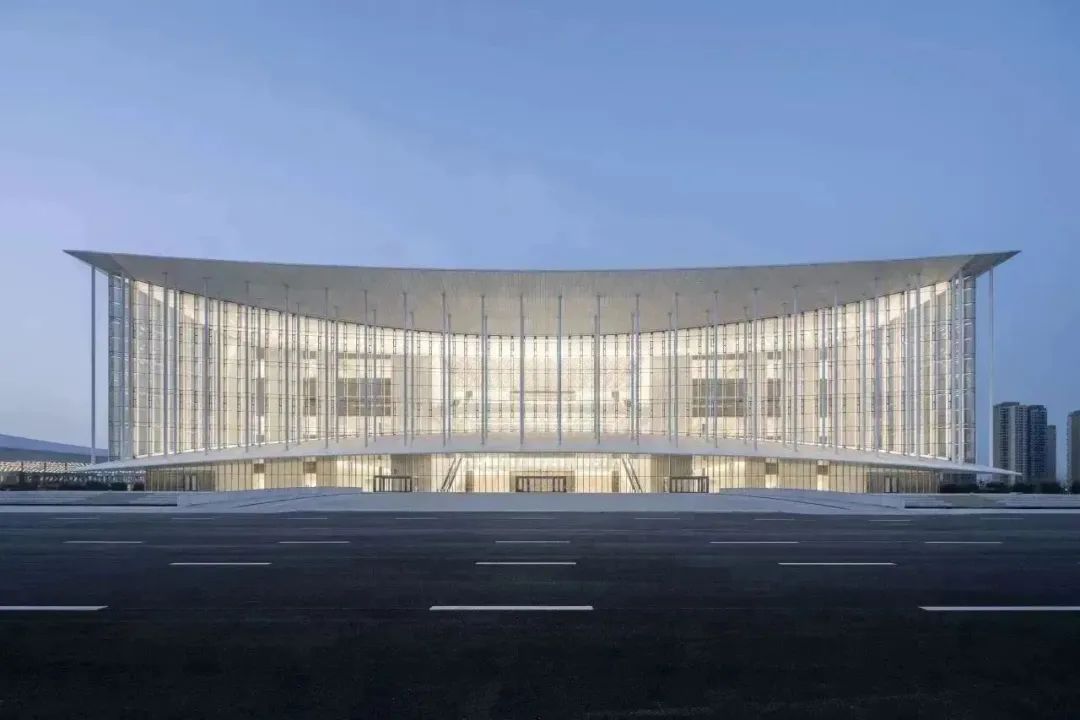
西安丝路国际会议中心 Silk Road International Conference Center © CreatAR
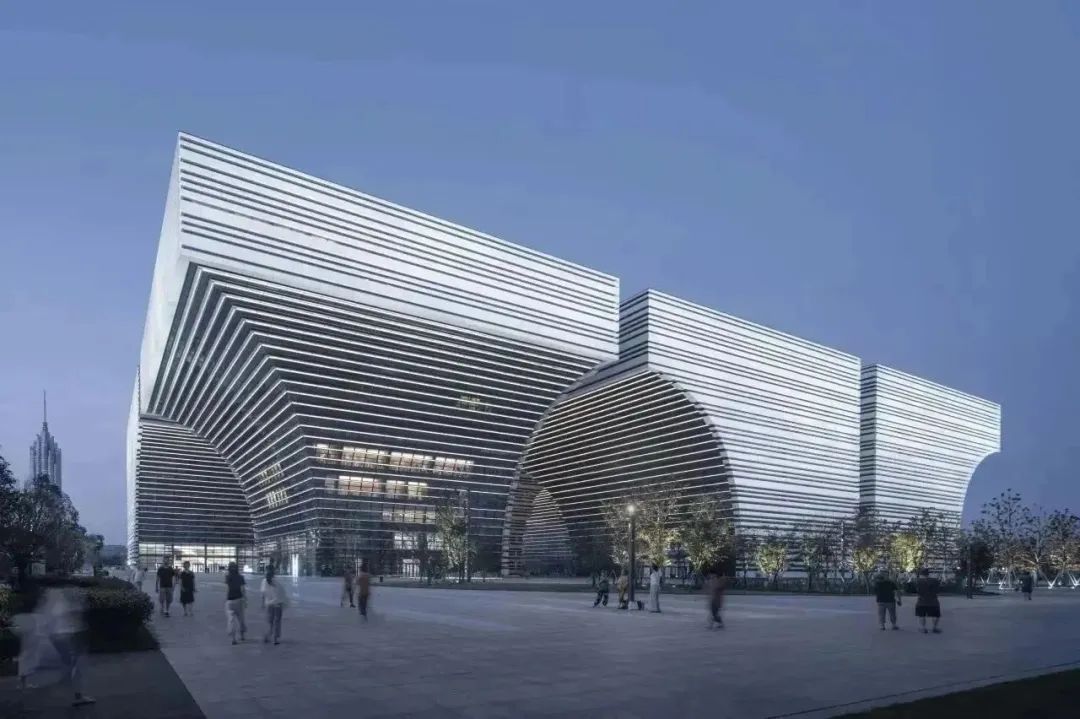
常州文化广场 Changzhou Culture Plaza © Schran Image
A
Wei Wu:
For example, the two projects have one thing in common: they were designed by Magdalena Weiss.
吴蔚:
两个项目其中一个共性就是由玛德琳·唯斯带领团队完成的设计。
Magdalene Weiss:
(laughs) The two projects were actually designed by our team in Shanghai. But both projects are also public buildings and they are both very large-scale. Both projects are intended to create an identity and have an impact in the urban space. In this context, both were construction tasks for which we were looking for expressive solutions. And in both cases, it is geometric elements with clear constructive principles that form the large-scale form and create the expression of the architecture.
玛德琳·唯斯:
(微笑)两个项目均由gmp上海团队完成。我们对于大型公共建筑设计的目标就是要为建筑创造自身独特的身份,在城市空间留下深刻印记。它们是gmp孜孜以求地追求具有表现力建筑过程中的重要尝试。我们尝试采用几何形态,遵循清晰的建筑原则,不仅构筑宏伟建筑,更为建筑赋予鲜明的表达力。
Q
Fabian Peters:
What expression did you want to achieve with the two projects?
法比安:
您希望通过两个项目表达什么理念?
A
Magdalene Weiss:
During the design phase, we always called the Silk Road Conference Centre “Halfmoon” – actually, “crescent moon” would have been more appropriate. The building has gentle curves at the base and base of the roof. The façade seems to literally float above the ground as it is suspended. This gives it an enormous lightness and transparency. The curved shapes are also a historical reference to the roofs of traditional public buildings in China.
玛德琳·唯斯:
我们设计团队习惯性地将西安丝路国际会议中心称为“半月”。但实际上称其为弯弯新月更为贴切。建筑在基座和屋顶设计采用柔和的曲线,整个建筑仿佛悬浮于地面之上,予人轻盈通透的质感。柔和曲线的造型来源于中国古建屋顶的营造艺术。
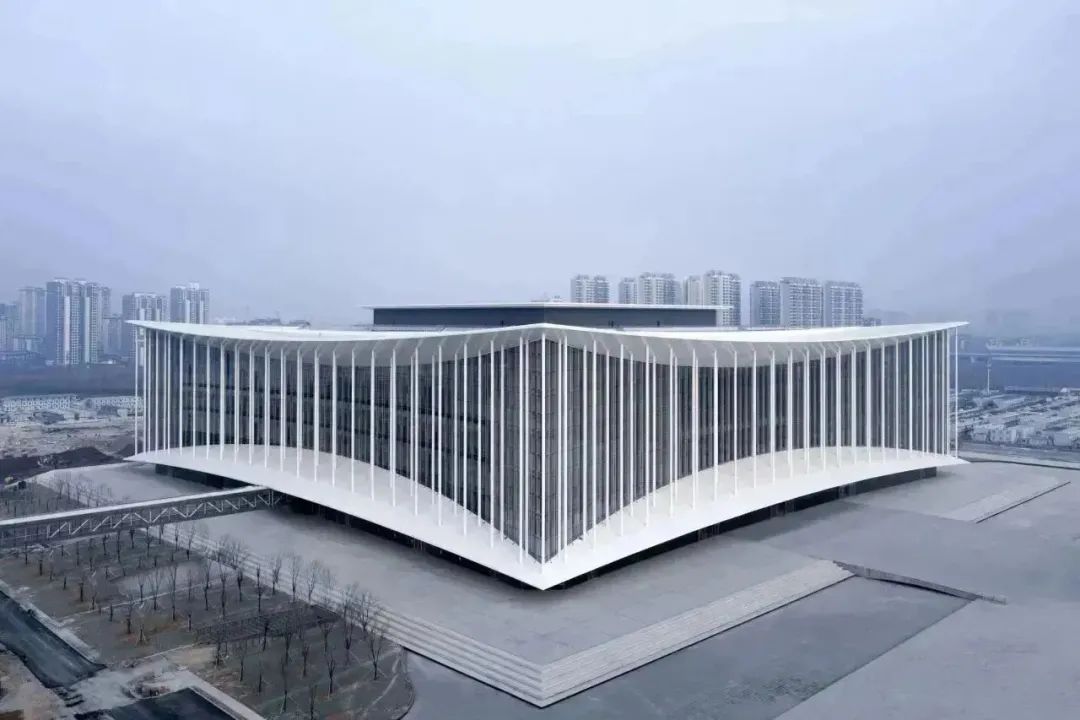
西安丝路国际会议中心 Silk Road International Conference Center © CreatAR
Q
Fabian Peters:
What about the Changzhou Culture Plaza?
法比安:
常州文化广场希望表达什么建筑艺术?
A
Magdalene Weiss:
We also used a catchy motif for the project in Changzhou. Here there are six modular elements which, when put together, create the image of bridge arches. The six structures are arranged on a large axis that runs towards the town hall.
玛德琳·唯斯:
我们赋予了常州文化广场引人瞩目的建筑特征:六座模块化建筑体量组合在一起时,形成一道拱桥造型,并沿着一条通往市政厅的大型主轴线排列。
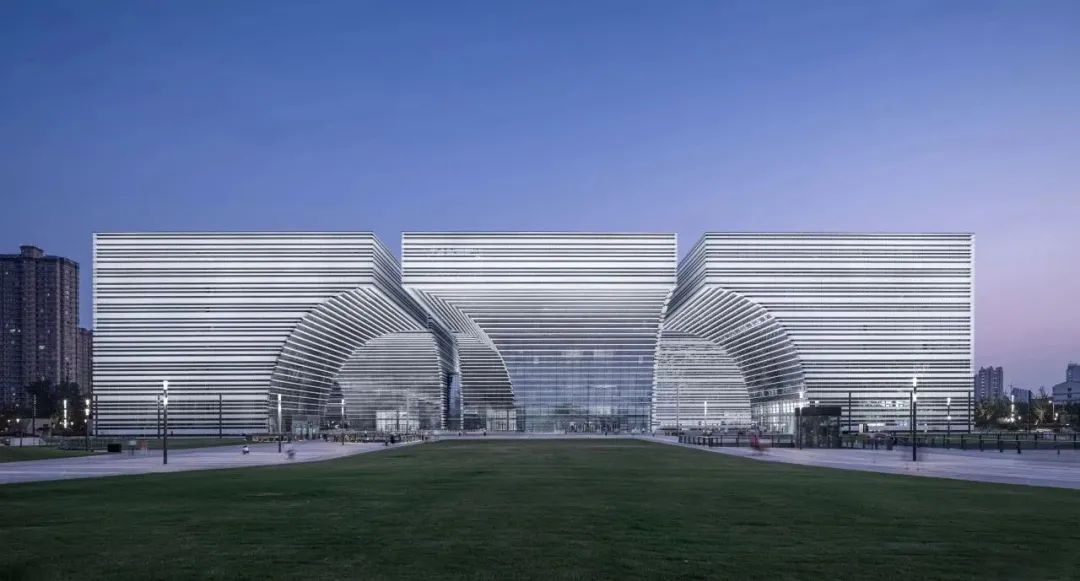
常州文化广场 Changzhou Culture Plaza © Schran Image
Q
Fabian Peters:
The enormous Silk Road Conference Center is designed as a large cubic form over a square floor plan. How do form and function relate to each other here?
法比安:
西安丝路国际会议中心被设计成大型立方体,矗立在四方形基座上。您是如何考虑外观和功能的相互关系的?
A
Magdalene Weiss:
The project was clearly developed from its function. More than 4,000 square metres of column-free hall space were required for the building. Large steel girders now span across these centrally positioned halls, resting on the vertical access cores and projecting beyond them. In this way, they not only bear the roof load, but also support the suspended façade.
玛德琳·唯斯:
我们遵循外观设计从功能出发的原则。该建筑要求至少四千平米的无柱大厅空间。大型钢梁现在横跨中央大厅,搁置在垂直核心筒上并延伸出去。钢梁不仅承担了屋顶的重量,同时也支撑着悬挂外立面。
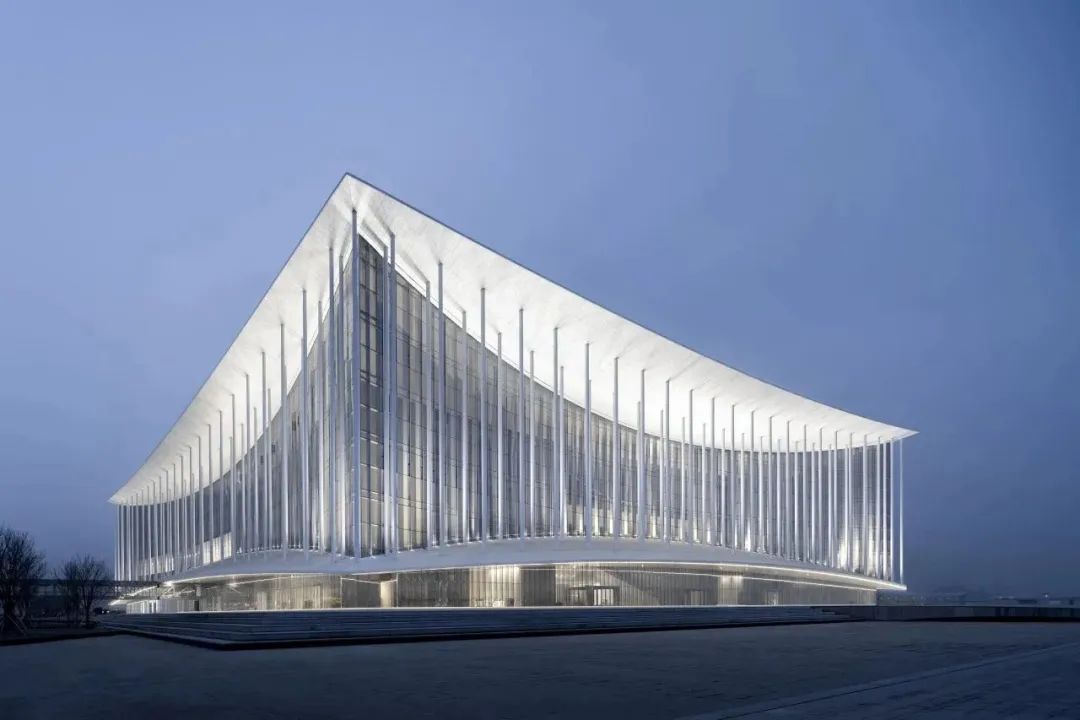
西安丝路国际会议中心 Silk Road International Conference Center © CreatAR
Q
Fabian Peters:
While the conference centre in Xi’an has to fulfil one main function, the Changzhou Culture Plaza accommodates a whole range of institutions.
法比安:
西安丝路国际会议中心承担的功能相对单一,但是常州文化广场却需要承载一系列不同的功能?
A
Magdalene Weiss:
That’s right. A library and an art museum were already planned from the outset. Initially, a technology museum was also planned, but this was not realised. Commercial uses were also planned. As the requirements kept changing significantly during the construction process, our design had to be able to react flexibly. We had to create spaces that could accommodate different uses and that could also be developed further.
玛德琳·唯斯:
确实如此。图书馆和美术馆需求在项目伊始就已确定。起初还计划设一个科技馆,但最终未能实现。项目需要兼顾商用。由于在建设过程中需求的变迁,建筑设计必须具备灵活应对的能力。最终我们创造出适应不同用途,并且还能进一步开发的空间。

西安丝路国际会议中心 Silk Road International Conference Center © CreatAR
Q
Fabian Peters:
How did gmp design the public space for the two projects?
法比安:
gmp如何设计两个项目的公共空间?
A
Magdalene Weiss:
The two projects are very different in their approach. The Silk Road Center forms the entrance to a large exhibition centre just outside the city centre. It therefore has very large foyer areas, typical of an exhibition centre. The Changzhou Culture Plaza is located in a newly developed city centre, surrounded by very dense residential development. There is a town hall, there are sports facilities – and there is a large public park that was developed together with the complex. We incorporated the urban environment into the design, as well as the new park, which expands under the arches and raised building volumes.
玛德琳·唯斯:
设计上它们有着显著的差异:西安丝路国际会议中心是塑造一个位于市郊的大型会展中心场地的入口,拥有宽敞的门厅区域,具有大型展览中心的显著特征。常州文化广场则位于城市新区的中心,周边环绕着稠密的住宅区。这里不仅有市民中心和体育设施,还有大型公园。我们特意将城市环境和建筑与公园相融合,并沿轴线延展到建筑拱门下的空间。
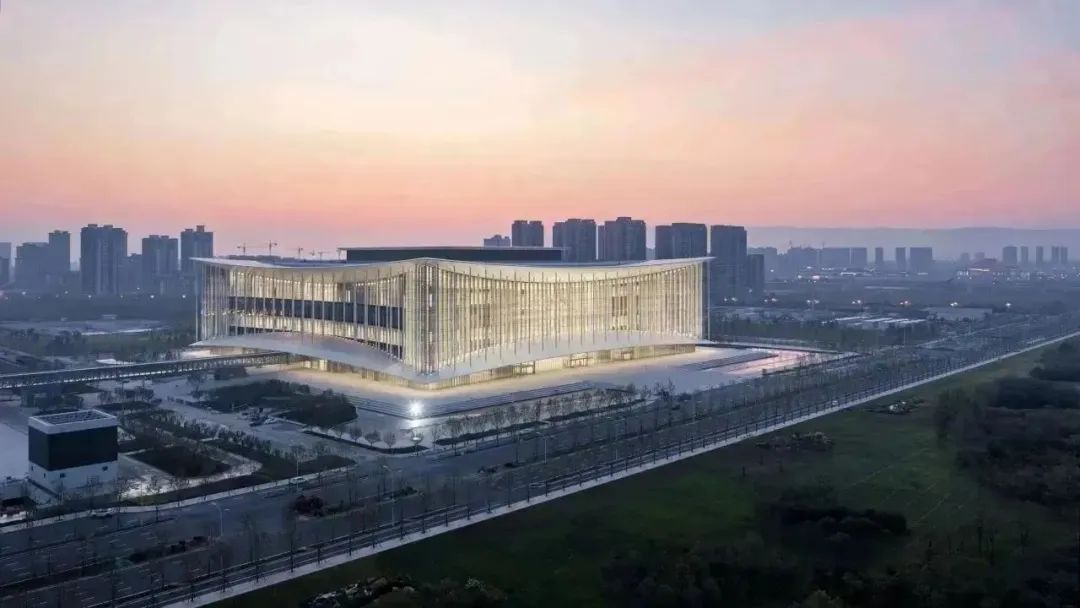
西安丝路国际会议中心 Silk Road International Conference Center © CreatAR

常州文化广场 Changzhou Culture Plaza © Schran Image
Q
Fabian Peters:
How does the approach to cultural projects in China differ from a project of the same kind in Europe?
法比安:
在中国从事文化建筑项目与在欧洲进行同类项目有何不同?
A
Wei Wu:
Unlike in Europe, cultural offerings have often been rare in China, even in large cities. There is often a lack of identity-creating architecture beyond commercial buildings and shopping malls. In Europe, when we are given the spatial programme for a cultural building, it is already worked out in great detail. In China, however, we as architects are often faced with the challenge when designing such cultural venues that there is neither an operator to begin with, nor has the final use been determined.
吴蔚:
与欧洲存在诸多的差别。中国特大城市中以往的文化建筑设施相对稀缺。除商业建筑和购物中心外,较少具备塑造城市身份的文化建筑。在欧洲,当我们负责一个文化建筑空间规划时,其设计任务书通常已经被精心制定。建筑师在中国设计文化建筑时,通场面临的挑战包括,未来建筑运营商及最终使用场景还在确定中。
Q
Fabian Peters:
How does gmp succeed in developing identity-creating architecture under the conditions in China?"
法比安:
gmp在中国设计出很多塑造城市身份的地标建筑,有什么成功秘诀?
A
Wei Wu:
This cannot be generalised. Xi’an, for example, is one of the former capitals of the Chinese Empire. The more than 2000-year-old army of clay soldiers that was discovered near Xi’an about 50 years ago is world-famous. The city has a very strong longing for tradition, including the continuation of tradition. After we had been working on the conference centre project for a year, we met the mayor, who was in favour of a building in the style of the Han and Tang dynasties. When such demands are made, most Chinese architects take a “post-modern” or “classical” path. I had already feared that we would have to give up. (laughs) But then we thought about whether we could translate certain ideas of traditional Chinese architecture into a modern language – especially the cantilevered roofs. Thanks to an ingenious steel construction, the roof of the conference centre now cantilevers over 40 metres without supports. Our interpretation of Chinese architecture was also very well received by the decision-makers. The result is a modern architecture that accepts the longing for Chinese tradition.
吴蔚:
没有放之皆准的方法。中国古都西安兵马俑经历两千年历史,五十多年前在西安被发现,享誉全球。西安对延续中华历史文化传统有着浓烈的渴望。在我们接手西安丝路国际会议中心工作一年后,我遇到了西安市的领导,他非常想建造一座具有汉唐风格的国际会议中心。我想多数建筑师会自然而然的在后现代或古典建筑风格里打转。我本已担心我们可能不得不最终放弃(笑)。经过精心思考,我们借鉴了中国传统建筑的出挑屋顶设计结构的某些理念,用现代建筑语言来表达。多亏了巧妙的钢结构设计,屋顶现在可以在没有立柱支撑的情况下悬挑40米。我们对中国传统建筑的这种诠释得到了城市决策者的高度首肯。最终诞生了一座渴望融入中国传统文化情怀的现代美学建筑。

吴蔚,摄影:Lukas Schramm Wei Wu, Foto: Lukas Schramm
Q
Fabian Peters:
The cultural centre in Changzhou speaks a completely different architectural language…
法比安:
常州文化广场展现出一种完全不同的建筑语言…
A
Magdalene Weiss:
The image of the bridge that we use there is also strongly abstracted by us due to the enormous scale. However, the bridge here is not only a formal idea, but also a static one, which is reflected in the structural realisation. Below the plaza with the cultural buildings are the commercial uses, which are arranged around a “canyon”. This division creates very special exterior and interior spaces that are highly attractive.
玛德琳·唯斯:
由于庞大的建筑体量,我们不得不极具抽象地呈现出拱桥形象。然而拱桥不止于形式,它具有结构作用。建筑下方是商业广场,围绕着峡谷式布局,从而创造出具有极高的吸引力非常独特的室内外空间。
Wei Wu:
If you have ever been to China, you will have noticed that such large buildings are often surrounded by fences or other protective measures. But the cultural centre in Changzhou really is freely accessible.
吴蔚:
如果您到访过中国,您可能会注意到类似这样的大型建筑通常被围墙或保护围栏所环绕,常州文化广场却是真正意义上对公众开放的。
Magdalene Weiss:
There is an outdoor stage, for example, which makes the area incredibly lively. It’s really busy every weekend. And there are also queues of people outside the library. It is visited by many young people. I’m delighted that the plaza is so popular and that it really is an extended public space.
玛德琳·唯斯:
常州文化广场建有户外舞台,非常有活力。每逢周末这里非常热闹。图书馆经常排成长龙,吸引了众多的年轻人。常州文化广场如此受欢迎,我深感欣慰,确实极大的扩展了公共空间。

常州文化广场 Changzhou Culture Plaza © Schran Image
Q
Fabian Peters:
Do expectations of public space in China differ from those in Europe?
法比安:
您可以介绍一下中国对公共建筑空间的期望与欧洲有什么不同?
A
Wei Wu:
In my perception, there are always two occasionally competing needs in China: On the one hand, the expectation of a prestigious urban space in which large state events can be held. On the other hand, there is also the expectation of a public space that citizens use in their everyday lives. Combining these two needs is of course a major challenge for any architect, who must always work closely with the client – and often also the authorities and the government – to find a solution.
吴蔚:
在我看来,在中国总是存在着两种有时相互竞争的需求:一方面,人们期望有一个能举办大型活动的仪式性城市空间。另一方面,也期待有一个公众在日常生活中使用的公共空间。对任何建筑师来说,将这两种需求结合无疑是一个巨大的挑战,我们必须始终与业主密切合作寻求解决方案,在中国大型文化建筑项目的业主通常是政府部门和相关单位。
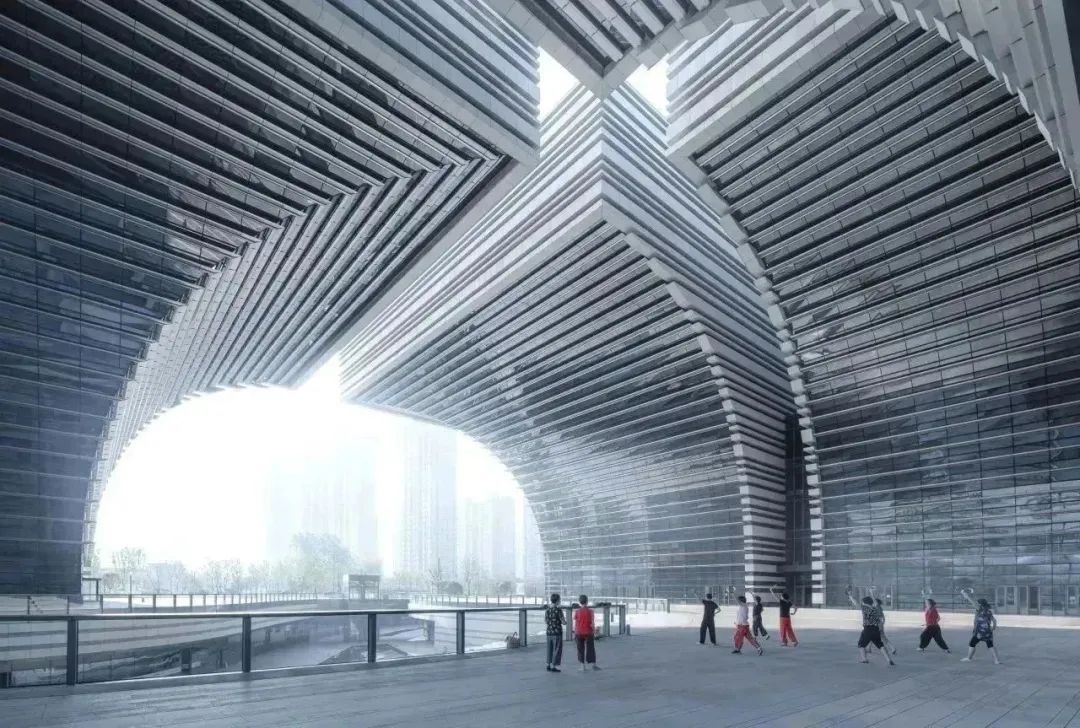
常州文化广场 Changzhou Culture Plaza © Schran Image
Q
Fabian Peters:
How close is the link between the projects that gmp is realising in Europe, North and South America and China?
法比安:
gmp内部在欧美和中国项目间如何密切协作?
A
Wei Wu:
One person from the circle of Executive Partners is responsible for all of our office’s projects. In this way, we maintain a high degree of continuity in the personal responsibility with which Meinhard von Gerkan and Volkwin Marg have characterised gmp for decades. We are united by a common foundation that is defined by the positions of dialogue-based design. We speak the same language in different dialects, as Meinhard von Gerkan once put it. In everyday life, we have a very close connection between Hamburg, Shanghai, Berlin and Beijing. And once a year, we come together from all locations to evaluate our current projects together. Video conferences, phone calls and emails between Germany and China take place every day.
吴蔚:
gmp每一位合伙人兼执行总裁负责协调不同区域办公室的所有项目。通过这种方式,我们保持了创始合伙人迈哈德·冯·格康(Meinhard von Gerkan)和沃尔克温·玛格(Volkwin Marg)几十年来为gmp制定的传统,从而保证了基于个人责任感的项目高度连续性。我们因对话式设计立场的共同基础而团结在一起。正如冯·格康先生曾经阐述:我们用不同的方言说着同一种语言。汉堡、上海、柏林和北京办公室之间在日常工作中非常紧密的团结协作。通过我们每年一次的gmp技术审阅年会,我们从各个地点聚在一起,共同评估我们当前的项目。中德团队之间的视频会议、电话和电邮每天都在频密的进行中。
Q
Fabian Peters:
What distinguishes the planning process with a Chinese client from that with a European client?
法比安:
中国和欧洲的设计规划过程有什么不同?
A
Magdalene Weiss:
In China, the desire for iconic buildings is particularly strong. The expression of architecture often takes centre stage.
玛德琳·唯斯:
在中国人们尤为强烈的渴望地标性建筑。建筑的表现形式常常是关注焦点。
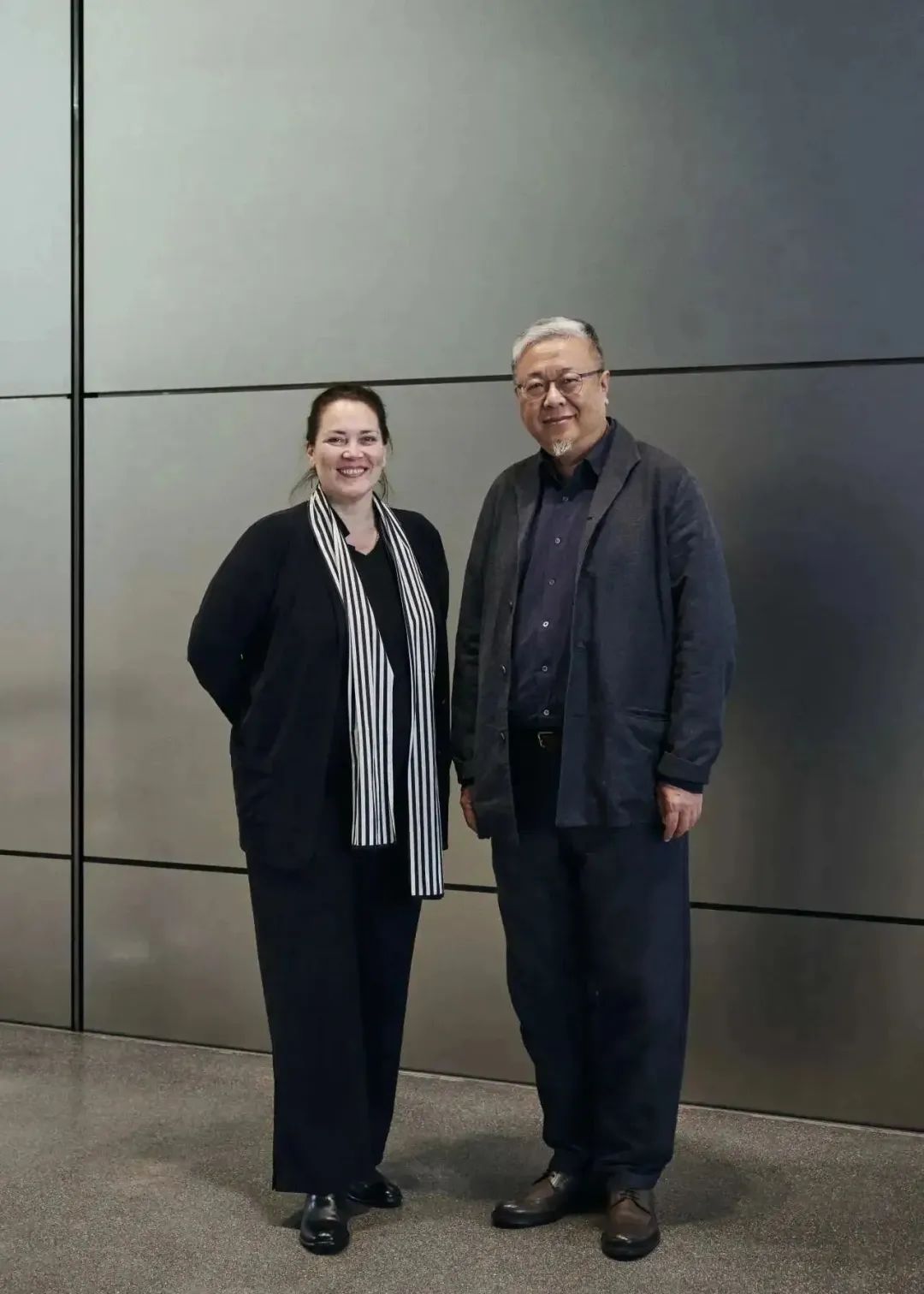
玛德琳·唯斯(左)和吴蔚(右),摄影:Lukas Schramm
Magdalene Weiss (left) and Wei Wu (right), Photo: Lukas Schramm
Q
Fabian Peters:
Do you miss the large-scale thinking in Europe compared to China?
法比安:
与中国相比,您是否觉得欧洲缺乏大规模思维?
A
Magdalene Weiss:
With individual projects in Europe, it is certainly the case that people work on a very small scale and wish things could be done faster. But I wouldn’t want to weigh up the different approaches against each other, because working on details can be very satisfying, especially if you know exactly who you are building for. In Chinese projects, there is sometimes a lack of time for this detailed work.
玛德琳·唯斯:
欧洲项目通常规模较小,人们也期待能再快一点。但我不想过多的相互比较。因为注重细节的工作也可以非常令人满足,尤其是当你确切知道这个建筑是为谁而建。在中国有时项目工期紧,缺乏出细活的时间。
Q
Fabian Peters:
In Germany, participation is now a big issue in major projects. Is this even imaginable in China?
法比安:
在德国公众参与已成为重大项目中的一个重要议题。中国也是这样吗?
A
Wei Wu:
There is an official instrument of participation in China – similar to the public interpretation in Germany: if we have won a competition, for example, the design is publicly displayed online and citizens are allowed to raise objections. However, other claims are then weighed against this public vote, so that their consideration is in no way certain.
吴蔚:
中国有一种公众参与机制,类似于德国的公众参与:我们赢得了一个设计竞赛后,设计方案就会在网上公示,公民可以提出建议。不过,公众投票结果会被总体权衡,所以最终是否会采纳各种建议存在不确定性。
Q
Fabian Peters:
Do you wish that citizens could be more involved in such processes?
法比安:
您希望更多的公民参与吗?
A
Wei Wu:
This has already begun in China’s major cities, particularly at the neighbourhood level, for example in Shanghai: there are so-called “chief planners”, “chief architects of streets”, who are responsible for certain neighbourhoods and streets. They are tasked by the city with initiating discussions and collecting feedback. However, I’m not sure whether this really takes place on a large scale.
吴蔚:
在中国主要城市其实已经开始实施,尤其在社区层面。上海有社区规划师、社区建筑师,他们负责特定的社区和街道规划。专家们被城市委托搜集意见和反馈。不过我不确定在上海发生的现象是否正在大规模发生。
Q
Fabian Peters:
In 2005, the exhibition “Ideal City – Real Projects. Von Gerkan, Marg and Partners in China”. How has architecture in China changed and developed since then?
法比安:
自2005年举办“理想城市—现实项目。gmp在中国”展览以来,中国在建筑设计上发生了怎样的变化?
A
Magdalene Weiss:
For example, there are now numerous remodelling projects in China. From large-scale urban growth at the beginning to building densification, the trend is now increasingly moving towards redevelopment and building in existing buildings. The idea of what a good city is has also changed. Shanghai, for example, has been opened up more and more to the water in recent years and at the same time the existing city centre has been upgraded.
玛德琳·唯斯:
如今中国有许多旧城改造项目。从最初的大规模城市密集化建设,现在的趋势越来越多地转向对现有建筑的再开发和改建。对于美好人居城市的理念也在发生变化。以上海为例,近年来越来越多地注重利用水域,同时城市中心也得到了升级。
Wei Wu:
Since gmp realised its first project in China in 1998 with the German School in Beijing, the quality of construction workmanship has improved enormously, as has the construction technology available. When China’s tallest building, the Shanghai Tower, was erected in 2015, only Chinese companies were involved.
吴蔚:
自从gmp1998年在中国实现首个项目北京德国学校以来,建筑工艺质量已经大幅提升,建筑技术有了显著进步。2015年中国最高建筑上海中心开建时,中国公司基本上能独立胜任。
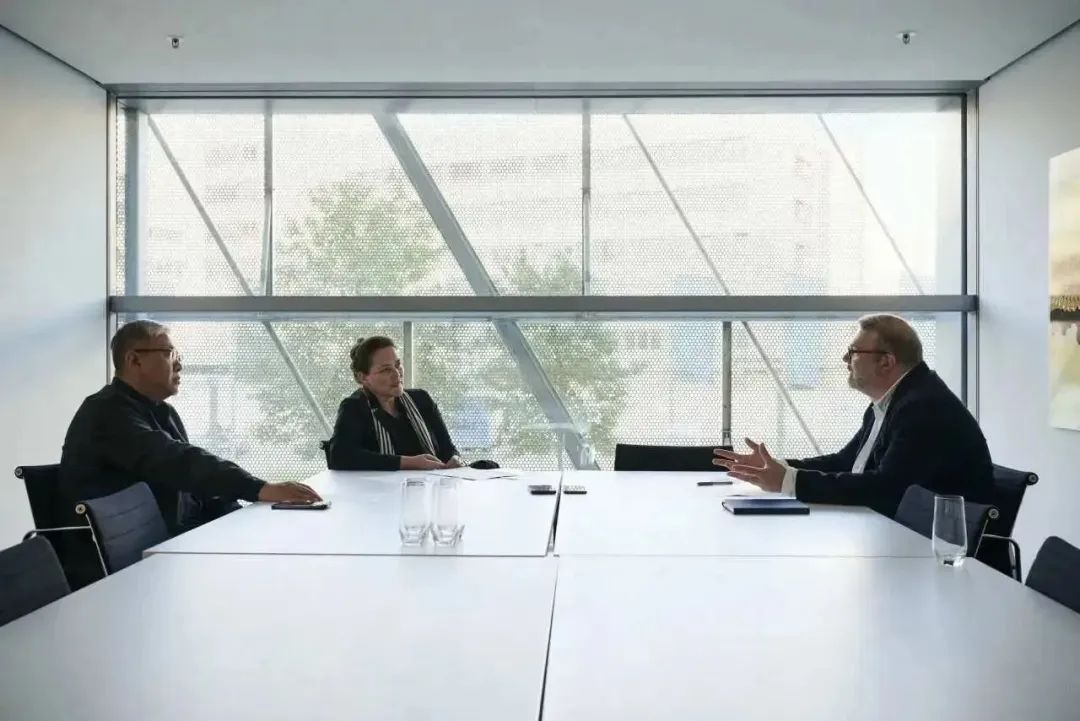
摄影:Lukas Schramm
Q
Fabian Peters:
Have the large international firms such as gmp contributed to China’s architecture being able to make such a “leap forward” in recent decades?
法比安:
gmp这样的大型国际建筑设计公司为中国建筑近几十年腾飞做出了什么样的贡献?
A
Wei Wu:
When I started working in China, the civil engineers always said: “You architects do the design. When you’ve finished your work, I’ll come to you.” In other words, the design process was a task for the architects, in which the civil engineers did not participate. This view is of course very different from the German way of thinking and working. In recent decades, gmp, together with other firms such as Henn Architekten and HPP, has exported the German way of working to China. But for me, there is still a big difference between the professional understanding of German and Chinese architects: In Germany, it’s all about how to build a house. That also means travelling to the building site and checking everything. (Laughter) In China, architects finalise their plans, hand them in and only return to the construction site occasionally. In the meantime, however, construction supervision by architects, as we know it from Germany, is slowly arriving in China. In my perception, this has led to a recognisably better quality of construction.
吴蔚:
1998年当我开始在中国工作时,结构工程师们总是说建筑师先做设计,你们完成后我们再介入。也就是说,方案设计是建筑师的任务,结构工程师并不参与。这当然与德国的思维和工作方式大相径庭。近几十年中gmp还有其它来自德国的建筑事务所,如德国海茵Henn和HPP等建筑设计公司,已将德国的工作方式引入中国。但在我看来,中德建筑师之间在专业理解上仍有很大差异:在德国一切都关乎建造房屋,这意味着建筑师要亲自前往建筑工地并检查一切细节。(笑声)在中国建筑师完成建筑设计后只是偶尔去到施工现场。与此同时,我们在德国所熟知的建筑师对施工的监理正逐渐在中国落地。在我看来,这项措施已经明显提升了建筑质量。
gmp·冯·格康,玛格及合伙人建筑师事务所是一家来自德国的国际化建筑事务所,总部位于汉堡,在全球多个国家与地区设立了分部。五十多年来,gmp依循一个共通的设计理念,与业主和各方合作团队建立起对话式关系,在世界各地不同的文化背景下从事不同规模的设计建造——由私人住宅到体育馆,由歌剧院到博物馆,由办公建筑到桥梁,由门把手到城市总体规划。
基于多年以来的相关经验,gmp将当下的城市化、数字化、历史建筑改造以及流动性等话题积极纳入设计的讨论范围。我们的建筑设计旨在保持美学价值的长久的生命力,以材料和气候条件为主导的建造品质保证了建筑的可持续性,并根据业界标准获得绿色建筑的相关认证。面对每一个设计任务,我们都致力于为使用者创造更多的公共价值。


特别声明
本文为自媒体、作者等档案号在建筑档案上传并发布,仅代表作者观点,不代表建筑档案的观点或立场,建筑档案仅提供信息发布平台。
18
好文章需要你的鼓励

 参与评论
参与评论
请回复有价值的信息,无意义的评论将很快被删除,账号将被禁止发言。
 评论区
评论区